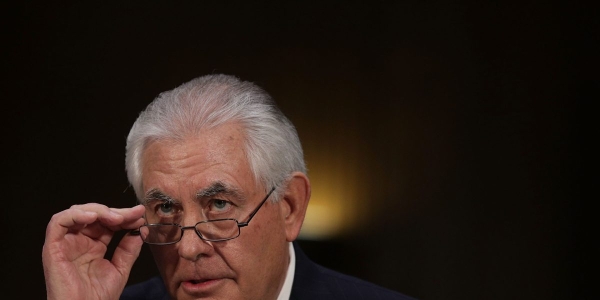
Gods, kings, and oil tycoons—they all have to fall from their high perch at some point or another, or at least downsize to less palatial grounds. Much like Marie Antoinette, ExxonMobil executives are moving house, leaving their Dallas-area home of a quarter century, the affectionately nicknamed “God pod,” and they’re leaving behind a downright Versailles-ian palace to boot. The deities of Big Oil’s 20th-century heyday are coming down to earth—sort of.
The move away from the God Pod was first disclosed back in January 2022, when Exxon announced it would be moving from Dallas to Houston in a drive to cut costs and streamline departments. The company said at the time that this would save $6 billion by 2023, funding 40% of its dividend payouts. It slimmed down to just three business lines: upstream, product solutions, and low-carbon efforts.
In its impending move to Houston, Exxon is going a bit less ham on its heavenly treatment of higher-ups. The God pod is the fittingly excessive name for the excessive executive suites at Exxon. As previously reported in Columbia Journalism professor Steve Coll’s business classic Private Empire and, more recently, the Wall Street Journal, the God pod is roughly 20,000 square feet and only accessible to a small handful ofthe very top executives (and their assistants), along with an assortment of private chefs and many fine sculptures and paintings.
Despite raking in record profits in 2022, people familiar with the matter told the Journal that the new office is in line with recent promises to adopt a leaner focus on spending and the new pod promises to be more economical, if maybe only slightly. Perhaps the God Pod’s aesthetic of decadence looks a bit old-fashioned, or even tacky, in an age of inflation and green transition, although the transition to Houston has been in the works for many years. The Houston campus, technically located in Spring, Texas, was opened back in 2014 by former CEO Rex Tillerson, holder of the “Order of Friendship” with Vladimir Putin’s Russia and then, briefly, secretary of state in the Trump White House. A representative from Exxon told Fortune they had nothing to add to the story.
“Closer collaboration and the new streamlined business model will enable the company to grow shareholder value and position ExxonMobil for success through the energy transition,” chief executive officer Darren Woods said in a statement to Bloomberg last year.
But what a pod they are leaving behind. Exxon decked out its home of a quarter century with French limestone and staircases imported from Africa, peppering the inside with paintings and sculptures. If one was to try to reproduce the palace, it would likely cost $1,000 per square foot, Doug Agarwal, founder and president of Texas-based real-estate firm CCI, tells the Journal, making the entire largely empty grounds likely worth around $20 million.
The new digs aren’t by any means something to scoff at, though a few changes are being made; the Journal notes that there will be no designated chef, but the private elevators will remain. And the executives won’t be hundreds of miles away from employees anymore—now they’ll just be two floors up, in the same campus spanning hundreds of acres. When it announced the move, in 2022, the Greater Houston Partnership touted the fact that the city would trail only New York and Chicago in Fortune 500 headquarters, with 25 in all.
Employees at Exxon’s headquarters have been expected to be in office five days a week since 2021, according to Bloomberg, though a representative told Fortune last year that workplace flexibility programs were in place. In an effort to get employees to return to office, CEOs have homed in on the ability to induce collaboration, also looking to monitor productivity like they could in the good ole days. But pushing for an office return due to greater teamwork might be difficult when workers can’t even rub shoulders with their executives. With a surface-level more modern aesthetic in Exxon’s new office, its usage might be less antiquated as well, as sources tell the Journal that the office will have more open space to stir collaboration.
“Senior global management is like divinity: Very few have access,” an employee in Exxon’s fuels and lubricants division told Business Insider in 2021.
After a difficult 2020 for Big Oil, investors are pressuring executives to cut costs. The new year marked a historical high for Exxon and the industry as a whole, as the company announced a record $56 billion profit in 2022. Even in a time of high inflation, where companies are cutting pandemic-era perks to save costs but also just look like the old era of a hardass boss, Exxon’s wallet still overflows.
The change from the God pod is likely in part an optics move as well. While major oil manufacturers are attempting what critics claim is “greenwashing” as criticism grows over their environmental impact, fossil-fuel demand is still high enough that some companies have dropped their performative activism altogether; the New York Times reports that Exxon ended its project in making environmentally friendly fuels made by algae.
As climate change intensifies, Americans start to publicly turn toward environmentally friendly options; a 69% majority support becoming carbon-neutral by 2020, according to Pew. Many blame companies, as two-thirds of respondents say that businesses aren’t doing enough to address climate change. As Big Oil looks worse during an era of visible environmental change, such lavishness at the top isn’t really a good look. Profiting from carbon emissions and exacerbating climate change are things that leaders of every party are happy to turn a blind eye to, but maybe it’s best to not let them eat cake too.